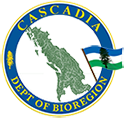Yurok (also Chillula, Mita, Pekwan, Rikwa, Sugon, Weitspek, and Weitspekan) is an Algic language. It is the traditional language of the Yurok of Del Norte County and Humboldt County on the northwest coast of California. The name Yurok comes from the Karuk ‘yuruk’, literally meaning ‘downriver’. The Yurok traditional name for themselves is Puliklah, from ‘pulik’ (‘downstream’) + -’la’ (‘people of’), thus equivalent in meaning to the Karuk name by which they came to be known in English.
Yurok is distantly related to its neighbor Wiyot, and to languages belonging to the Algonquian language family spoken across central and eastern North America, including Blackfoot, Cree, Ojibwe, and many others. Linguists believe that Wiyot, Yurok, and all the Algonquian languages descend from a single common ancestor spoken thousands of years ago, perhaps somewhere in present-day eastern Washington or Oregon or northern Idaho. The relations and history of these languages are areas of active research among linguists, archaeologists, and historians.
<div class="sqs-video-wrapper" data-provider-name="YouTube" data-html="
<iframe src="//www.youtube.com/embed/QRXZ_9gb8lc?wmode=opaque" height="480" width="854" scrolling="no" frameborder="0" allowfullscreen></iframe>
“>
Yurok nouns and verbs are assembled and change their forms in patterns that are sometimes elaborate, expressing a variety of meanings. Unlike English, where most nouns change their form to make them plural (cat vs. cats, for example, or man vs. men), Yurok nouns usually do not change their form: puesee can mean “cat” or “cats”, and ‘yoch can mean “boat” or “boats”. However, a very few nouns do change their form:
mewah mewahsegoh perey pegerey wer’yers wer’yernerk huuek huueksoh
“Boy” “Boys” “Old Woman” “Old Women “Girl” “Girls” “Child” “Children”
However, unlike English, Yurok nouns do sometimes change their form to refer to locations:
mech mecheek yoch yoncheek “
“Fire” “in the fire” “boat” “in a boat”
Verbs, meanwhile, can change depending on the subject:
kooychkwok’ kooychkwoh kooychkwoom’
“I buy it.” “we buy it” “you buy it”
“kooychkwoow’ kooychkwom’ kooychkwohl
“You (plural) buy it.” “He/She buys it.” “They buy it”
A fascinating aspect of the Yurok language, one that is quite unlike English, is the intricate way that certain meaningful elements combine in the formation of verbs. The table below illustrates typical combinations of elements, used to form verbs with distinct but related meanings. Notice the elements heem- “fast”, kwomhl- “back”, pkw- “out from an enclosed area”, and yohp- “in a circle”, to which are added -ech- “go” and -o’rep- “run”:
heemechok heemo’repek kwomhlechok kwomhlo’repek
“I hurry” “I run quickly” “I return” I run back”
pkwechok pkwo’repek’ yohpechok’ yohpo’repek’
“I emerge” “I run out of an enclosed area” “I go in a circle” “I run in a circle”
Yurok sentence patterns are quite different from English patterns; in English, most sentences contain at least a verb (a word like walk, see, know, etc., usually naming an action, experience, situation, etc.) and a subject (indicating who did the action, experienced a situation, etc.): The horse walked, or My teacher sees you, or Your children love pie. But a verb is enough in Yurok, and many Yurok sentences consist of a single word — a verb:
Hlmeyorkwochek’ Kwerykweryochem’. ‘Sleryhlkerp’erk’
I’m afraid of you.’ ‘You are whistling.’ ‘I’m going to blow my nose.’
In English, the basic word order of subject, verb, and object (in sentences that have objects, for example indicating who or what an action was done to) is usually fixed. In Yurok the order of these elements is flexible, depending largely on emphasis and discourse structure. For example, if the context is unambiguous, either of the following sentences might be interchangeable:
Kue pegerk helomey’ Helomey’ kue pegerk
[article] man to dance – 3sg.infl to dance – 3sg.infl [article] man
The man dances. the man dances.
Compared to English, Yurok word order possibilities are more flexible in sentences like these, but it is not always straightforward to learn the emphasis and discourse patterns that determine which order is used.
One important way Yurok and English sentence patterns differ is that Yurok has a large class of preverbs: short words, typically, that express relative time, location, negation, and relations between events, among many other meanings. As the name suggests, preverbs occur before the verb in a sentence. In the following sentences, for example, the preverb keech means something recently started happening and is still happening, the preverb kee means something will happen in the future, and the preverb combination keech + ho means something has already happened (and is still true).
Keech keepuen Kee kochpoksek’ Kues keech ho neskwechoom’? Kues keech ho neskwechoom’?‘
“It’s winter (now)” “I will think it over.” “I will think it over.” “When did you arive?”
Preverbs are used in almost every Yurok sentence, and it is common for two, three, or even more to be combined in a sentence. The idiomatic use of preverb combinations is an indication of real fluency in the language.
Decline of the language began during the California Gold Rush, due to the influx of new settlers and the diseases they brought with them. Native American boarding schools initiated by the United States government with the intent of incorporating the native populations of America into mainstream American society increased the rate of decline of the language. The language was officially declared extinct with the death of Archie Thompson, the last native speaker, on March 26, 2013
However, a language revival program The program to revive Yurok has been lauded as the most successful language revitalization program in California. As of 2014, there are six schools in Northern California that teach Yurok – 4 high schools and 2 elementary schools.



Post a comment